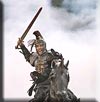

Sir Tristan, whose name means "sorrow", was so called because of his mother's death at his own birth. Tristan was a noble knight with all the necessary skills of hunting, jousting, dancing, and harp playing. Tristan is now remembered for his love affair with Isolde.. His uncle, King Mark of Cornwall, sent Tristan to Ireland to escort the beautiful Isolde back to Cornwall to marry King Mark. On the voyage back to England, Tristan and Isolde drank a love potion mistakingly believingt hat it was wine. This potion, which had been meant to enhance the marriage of Mark and Isolde, instead bound Tristran and Isolde inextricably and tragically in love.
A possible grave site for Tristran is the Tristan Stone is just outside of Fowey in Cornwall, near Castle Dore. An informative plaque marks the site, placed there by the Old Cornwall Society. The original stone is thought to have been erected around 550 AD. On the north side is a raised T, thought to represent a Christian Cross. On the south face of the pillar, the 6th century "Tristan" inscription was still faintly visible, though well weathered. Excavations have shown that the hill itself was occupied in roughly the correct time frame.
Isolde married King Mark of Cornwall, but the love affair with Tristan continued after her wedding. King Mark eventually learns of the affair, forgives Isolde, but exiles Tristan from Cornwall. Tristan moved to the court of King Arthur and went to Brittany, where he met Iseult of Brittany. Apparently he was attracted to her because of the similarity of her name to that of Isolde. He married Iseult, but continued to love Isolde.
Variations of Tristan and Isolde story have existed in a number of forms down the ages.
Full references to more about Sir Tristan at the Rochester site
Return to the Knights of the Round Table
